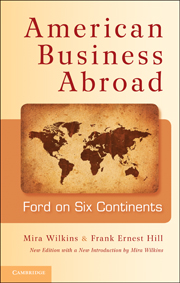Book contents
- Frontmatter
- Contents
- List of Illustrations
- Preface
- Introduction to the New Edition
- Introduction to the First Edition
- 1 First Venture
- 2 Probing for Markets
- 3 Model T: Triumph and Fable
- 4 The Alchemy of War
- 5 Steps in Expansion
- 6 The Sun Never Sets
- 7 Prosperity and Frustration
- 8 The Missionary Spirit
- 9 The Best-Laid Plans
- 10 Marriage of Convenience
- 11 Time of Desperation
- 12 A World Disturbed
- 13 Extreme of Nationalism
- 14 The British Empery
- 15 On Both Sides of World War II
- 16 The Crippled Phoenix
- 17 The New Company
- 18 Manufacturing for World Markets: From Dagenham to Geelong
- 19 New Times, New Faces, New Policies
- Appendices
- Bibliographical Essay
- Notes
- Index
- Titles in the series
- Plate section
Introduction to the First Edition
Published online by Cambridge University Press: 05 June 2012
- Frontmatter
- Contents
- List of Illustrations
- Preface
- Introduction to the New Edition
- Introduction to the First Edition
- 1 First Venture
- 2 Probing for Markets
- 3 Model T: Triumph and Fable
- 4 The Alchemy of War
- 5 Steps in Expansion
- 6 The Sun Never Sets
- 7 Prosperity and Frustration
- 8 The Missionary Spirit
- 9 The Best-Laid Plans
- 10 Marriage of Convenience
- 11 Time of Desperation
- 12 A World Disturbed
- 13 Extreme of Nationalism
- 14 The British Empery
- 15 On Both Sides of World War II
- 16 The Crippled Phoenix
- 17 The New Company
- 18 Manufacturing for World Markets: From Dagenham to Geelong
- 19 New Times, New Faces, New Policies
- Appendices
- Bibliographical Essay
- Notes
- Index
- Titles in the series
- Plate section
Summary
It was counted a proud achievement when the first American manufactures—Singer sewing-machines, the Yale locks, the McCormick reapers and mowers—were exported in quantity to Europe. The planting of American branch factories in foreign lands, a necessary subsequent step for reducing transportation costs, avoiding tariffs or other restrictions on trade, and cultivating the good will of peoples, was a much tardier development. It was not until after 1900 that such branches became numerous. Since the Second World War, however, thousands of American firms have created important interests overseas, and more than 3,300 were by 1961 doing business abroad through branches, subsidiaries, or other forms of investment.
This expansion deserves far more study than it has received. Most Americans know something about the adventures of individual figures abroad, from Benjamin Franklin and Washington Irving to Dwight D. Eisenhower and T. S. Eliot; but they are ill-informed upon the record of our great economic units.
This book is the first full-length history of the activities of an American company that early became a multinational enterprise and swiftly grew so successful that its name was (and is) familiar to every child on six continents. The story is of direct importance to the many men and women who, as corporation employees, stockholders, salesmen, or government officers, have a material stake in the way in which our companies are shaping their overseas policies.
- Type
- Chapter
- Information
- American Business AbroadFord on Six Continents, pp. xxv - xxviiiPublisher: Cambridge University PressPrint publication year: 2011

